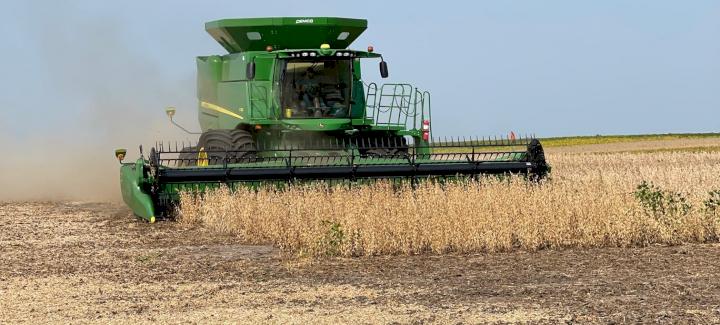Prep Your Harvest Equipment to Prevent Untimely (and Costly) Breakdowns
September 2021
Harvest is around the corner for many across the Corn Belt. In fact, we’re already combining some of our plots at the Stine Seed Farm in Adel, Iowa. According to the September 13 United States Department of Agriculture’s National Agricultural Statistics Service, only 4% of the nation’s corn crop has been harvested. There’s still plenty of time to prep your harvest equipment, so we’ve brushed off a few of our favorite tips to help prevent untimely (and costly) breakdowns this fall.
Plan Ahead
Time is hard to come by for farmers who are already tasked with scouting crops and evaluating products for next year. But it’s important to set aside a few days for equipment inventory before harvest begins to check for any necessary repairs. Last-minute repairs can be costly and, depending on when parts can be delivered and installed, can greatly set back your harvest timeline. Consider making a checklist of your harvest equipment, including what parts to review and what machinery to test well in advance of hitting the fields. Then, set aside a few days to evaluate each piece of equipment to get a head start on necessary repairs. Even if you've already started combining, there's still time to check your equipment before you get into the full swing of harvest.
Check Your Engines Before You Start Your Engines
Always check your equipment engines for red flags before you give it the green light for harvest. This is especially important as combines have likely sat idle for most of the year, if not for an entire year. Our experts recommend checking and cleaning the posts and cables around the battery to make sure there are no signs of wear and tear or heavy grime that could prevent the battery from properly functioning. Consider using a pressure washer to help remove dirt and grime or caked-on grease that could result in a fire down the road. If engines have difficulty starting or burn through fuel, it may be worth consulting a mechanic.
Inspect, Secure, Fill and Clean Even the Smallest Parts
If your machinery endured last year’s harvest and sat idle for the year, it’s likely gathered a lot of dust and dirt over the months. Cleaning up equipment is extremely important before hitting the field. In fact, combine and tractor fires result in more than $20 million in property losses each year, and 75% of machinery fires begin in the engine. Think of the loss of income and loss of time that results from something that may have been prevented by a simple inspection. Be sure to inspect, secure, fill and clean the following on your combines, tractors and other equipment this fall:
- Batteries — A dead battery means your equipment won’t operate. Always check your battery to ensure it holds a charge, and also clean the battery to remove any grease, dust or corrosion to ensure a better connection.
- Hoses — Most equipment has several hoses to inspect. Be sure to look for cracks or leaks and replace any worn-down hoses before you operate your machinery.
- Belts and chains — Like hoses, check any belts and chains for wear and tear. Ensure all belts and chains are secure and ready for use. Replace any that seem worn or stretched. Also, make sure they're properly tightened to manufacturer specifications.
- Fuel lines — Leaking fuel lines can be devastating to equipment and can also lead to engine fires. Always check your fuel lines to ensure they’re not cracked or leaking fuel.
- Fluids — As you would with a vehicle, always check your equipment fluids — coolant, oil, fuel, hydraulic and any other fluid your equipment uses.
- Tires — A flat or popped tire can slow down harvest. Check for wear on each tire, from the combine to grain carts to field trucks. Also, check the tires for proper pressure and to ensure uniformity across equipment.
- Lightbulbs — Growers often burn the midnight oil during harvest to ensure all crops are out when they’re ready. Burned-out lightbulbs can be hazardous in the early mornings or late night when operating equipment, not only for the operator but also for others driving down country roads or busy highways where equipment is traveling. Make sure to test all headlights, taillights and turn signals on your equipment.
- Nuts and bolts — Loose equipment is never a good thing. Check out all the nuts and bolts on your equipment to ensure they’re properly secured and ready for use.
- Electronics — Most equipment nowadays has several electronics, such as monitors, GPS and other precision software to ensure a more efficient harvest. Always test and calibrate electronics before you hit the field.
Remember: Safety First
Next week is National Farm Safety and Health Week, but farm safety should be a top priority year-round. Not only do you want your equipment to be safe for a successful harvest, but you also need to be more aware of your own surroundings and well-being in the field and on the road. Stay tuned for our next edition of Stine Weekly, where we’ll discuss tips for farm safety, which is especially important as we head into the busy harvest season.
In the meantime, if you have any questions on prepping your equipment for harvest, your local Stine agronomist can assist or put you in touch with an equipment expert. Happy harvesting!
Related Articles
-

Stine® to offer Syngenta’s Victrato® soybean seed treatment in 2026
December 2025 in Agronomy
-

Use Stine’s XP® seed treatments to prevent early injury to your crops
December 2025 in Agronomy
-

Understanding Stine’s enhanced oil profile soybeans
December 2025 in Agronomy
-

Soil sampling sets the stage for spring
November 2025 in Agronomy



